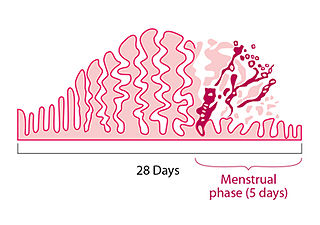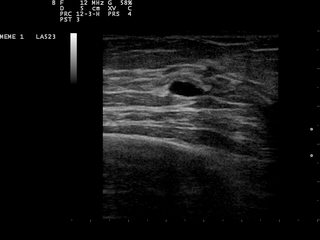Related Research Articles

The breast is one of two prominences located on the upper ventral region of a primate's torso. Both females and males develop breasts from the same embryological tissues.

Menstruation is the regular discharge of blood and mucosal tissue from the inner lining of the uterus through the vagina. The menstrual cycle is characterized by the rise and fall of hormones. Menstruation is triggered by falling progesterone levels and is a sign that pregnancy has not occurred.

The nipple is a raised region of tissue on the surface of the breast from which, in females, milk leaves the breast through the lactiferous ducts to feed an infant. The milk can flow through the nipple passively or it can be ejected by smooth muscle contractions that occur along with the ductal system. Male mammals also have nipples but without the same level of function, and often surrounded by body hair.
Premenstrual syndrome (PMS) is a disruptive set of emotional and physical symptoms that regularly occur in the one to two weeks before the start of each menstrual period. Symptoms resolve around the time menstrual bleeding begins. Different women experience different symptoms. Premenstrual syndrome commonly produces one or more physical, emotional, or behavioral symptoms, that resolve with menses. The range of symptoms is wide, and most commonly are breast tenderness, bloating, headache, mood swings, depression, anxiety, anger, and irritability. To be diagnosed as PMS, rather than a normal discomfort of the menstrual cycle, these symptoms must interfere with daily living, during two menstrual cycles of prospective recording. These symptoms are nonspecific and are seen in women without PMS. Often PMS-related symptoms are present for about six days. An individual's pattern of symptoms may change over time. PMS does not produce symptoms during pregnancy or following menopause.

Mastitis is inflammation of the breast or udder, usually associated with breastfeeding. Symptoms typically include local pain and redness. There is often an associated fever and general soreness. Onset is typically fairly rapid and usually occurs within the first few months of delivery. Complications can include abscess formation.

Nipple discharge is fluid from the nipple, with or without squeezing the breast. The discharge can be milky, clear, green, purulent, bloody, or faintly yellow. The consistency can be thick, thin, sticky, or watery.

Vaginal bleeding is any expulsion of blood from the vagina. This bleeding may originate from the uterus, vaginal wall, or cervix. Generally, it is either part of a normal menstrual cycle or is caused by hormonal or other problems of the reproductive system, such as abnormal uterine bleeding.

Danazol, sold as Danocrine and other brand names, is a medication used in the treatment of endometriosis, fibrocystic breast disease, hereditary angioedema and other conditions. It is taken by mouth.

Lactiferous ducts are ducts that converge and form a branched system connecting the nipple to the lobules of the mammary gland. When lactogenesis occurs, under the influence of hormones, the milk is moved to the nipple by the action of smooth muscle contractions along the ductal system to the tip of the nipple. They are also referred to as galactophores, galactophorous ducts, mammary ducts, mamillary ducts or milk ducts.

A menstrual disorder is characterized as any abnormal condition with regards to a person's menstrual cycle. There are many different types of menstrual disorders that vary with signs and symptoms, including pain during menstruation, heavy bleeding, or absence of menstruation. Normal variations can occur in menstrual patterns but generally menstrual disorders can also include periods that come sooner than 21 days apart, more than 3 months apart, or last more than 10 days in duration. Variations of the menstrual cycle are mainly caused by the immaturity of the hypothalamic-pituitary-ovarian (HPO) axis, and early detection and management is required in order to minimize the possibility of complications regarding future reproductive ability.

Ptosis or sagging of the female breast is a natural consequence of aging. The rate at which a woman's breasts drop and the degree of ptosis depends on many factors. The key factors influencing breast ptosis over a woman's lifetime are cigarette smoking, her number of pregnancies, higher body mass index, larger bra cup size, and significant weight change. Post-menopausal women or people with collagen deficiencies may experience increased ptosis due to a loss of skin elasticity. Many women and medical professionals mistakenly believe that breastfeeding increases sagging. It is also commonly believed that the breast itself offers insufficient support and that wearing a bra prevents sagging, which has not been found to be true.

Fibrocystic breast changes is a condition of the breasts where there may be pain, breast cysts, and breast masses. The breasts may be described as "lumpy" or "doughy". Symptoms may worsen during certain parts of the menstrual cycle due to hormonal stimulation. These are normal breast changes, not associated with cancer.
Breast diseases make up a number of conditions. The most common symptoms are a breast mass, breast pain, and nipple discharge.

A breast cyst is a cyst, a fluid-filled sac, within the breast. One breast can have one or more cysts. They are often described as round or oval lumps with distinct edges. In texture, a breast cyst usually feels like a soft grape or a water-filled balloon, but sometimes a breast cyst feels firm.
Ovarian diseases refer to diseases or disorders of the ovary.

Duct ectasia of the breast, mammary duct ectasia or plasma cell mastitis is a condition that occurs when a milk duct beneath the nipple widens, the duct walls thicken, and the duct fills with fluid. This is the most common cause of greenish discharge. Mammary duct ectasia can mimic breast cancer. It is a disorder of peri- or post-menopausal age.
Estrogen dominance (ED) is a theory about a metabolic state where the level of estrogen outweighs the level of progesterone in the body. This is said to be caused by a decrease in progesterone without a subsequent decrease in estrogen.

A breast mass, also known as a breast lump, is a localized swelling that feels different from the surrounding tissue. Breast pain, nipple discharge, or skin changes may be present. Concerning findings include masses that are hard, do not move easily, are of an irregular shape, or are firmly attached to surrounding tissue.
An estrogen-dependent condition can be that relating to the differentiation in the steroid sex hormone that is associated with the female reproductive system and sex characteristics. These conditions can fall under the umbrella of hypoestrogenism, hyperestrogenim, or any sensitivity to the presence of estrogen in the body.
Nipple pain is a common symptom of pain at the nipple that occurs in women during breastfeeding after childbirth. The pain shows the highest intensity during the third to the seventh day postpartum and becomes most severe on the third day postpartum.
References
- 1 2 3 4 5 6 7 8 9 10 11 12 13 14 15 16 17 18 19 20 Salzman, B; Fleegle, S; Tully, AS (15 August 2012). "Common breast problems". American Family Physician. 86 (4): 343–9. PMID 22963023.
- 1 2 3 4 5 6 7 8 Iddon, J; Dixon, JM (13 December 2013). "Mastalgia". BMJ (Clinical Research Ed.). 347: f3288. doi:10.1136/bmj.f3288. PMID 24336097. S2CID 220173019.
- 1 2 3 4 5 "Breast pain". nhs.uk. 17 October 2017. Retrieved 11 November 2022.
- ↑ Mazza, Danielle (2011). Women's Health in General Practice. Elsevier Health Sciences. p. 189. ISBN 978-0729578714.
- 1 2 3 4 5 6 7 8 9 10 11 12 13 14
 This article incorporates text from this source, which is in the public domain : "Breast pain: MedlinePlus Medical Encyclopedia". medlineplus.gov. Retrieved 14 August 2017.
This article incorporates text from this source, which is in the public domain : "Breast pain: MedlinePlus Medical Encyclopedia". medlineplus.gov. Retrieved 14 August 2017. - ↑ Dogliotti, L; Faggiuolo, R; Ferusso, A; Orlandi, F; Sandrucci, S; Tibo, A; Angeli, A (1985). "Prolactin and thyrotropin response to thyrotropin-releasing hormone in premenopausal women with fibrocystic disease of the breast". Hormone Research. 21 (3): 137–44. doi:10.1159/000180038. PMID 3922866.
- ↑ Dogliotti, L; Orlandi, F; Angeli, A (1989). "The endocrine basis of benign breast disorders". World Journal of Surgery. 13 (6): 674–9. doi:10.1007/BF01658413. PMID 2696218. S2CID 7420761.
- 1 2 3 4 5 6 Cash, Jill (2014). Family practice guidelines. New York: Springer Publishing. ISBN 9780826197825., [Electronic book] Section I Guidelines, Chapter Thirteen: Gynecologic Guidelines-Breast Pain
- 1 2 3 4 5 6 7 Brown, Ken. "Breast Pain Causes and Diagnosis: Johns Hopkins Breast Center" . Retrieved 14 August 2017.
- ↑
 This article incorporates text from this source, which is in the public domain : "Thrush in newborns: MedlinePlus Medical Encyclopedia". medlineplus.gov. Retrieved 3 August 2017.
This article incorporates text from this source, which is in the public domain : "Thrush in newborns: MedlinePlus Medical Encyclopedia". medlineplus.gov. Retrieved 3 August 2017. - ↑ Walker, Marsha (2011). Breastfeeding management for the clinician : using the evidence. Sudbury, Mass: Jones and Bartlett Publishers. p. 533. ISBN 9780763766511.
- ↑ Santos, Kamila Juliana da Silva; Santana, Géssica Silva; Vieira, Tatiana de Oliveira; Santos, Carlos Antônio de Souza Teles; Giugliani, Elsa Regina Justo; Vieira, Graciete Oliveira (2016). "Prevalence and factors associated with cracked nipples in the first month postpartum". BMC Pregnancy and Childbirth. 16 (1): 209. doi:10.1186/s12884-016-0999-4. ISSN 1471-2393. PMC 4975913 . PMID 27496088.
- ↑ "Sore or cracked nipples when breastfeeding, Pregnancy and baby guide". www.nhs.uk. National Health Services (UK). Retrieved 4 August 2017.
- ↑ Kerri Durnell Schuiling; Frances E. Likis (2011). Women's Gynecologic Health. Jones & Bartlett Publishers. pp. 381–. ISBN 978-0-7637-5637-6.